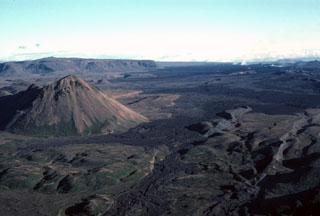Report on Krafla (Iceland) — November 1978
Scientific Event Alert Network Bulletin, vol. 3, no. 11 (November 1978)
Managing Editor: David Squires.
Krafla (Iceland) New deflation event; intrusion to 25 km N of the caldera
Please cite this report as:
Global Volcanism Program, 1978. Report on Krafla (Iceland) (Squires, D., ed.). Scientific Event Alert Network Bulletin, 3:11. Smithsonian Institution. https://doi.org/10.5479/si.GVP.SEAN197811-373080
Krafla
Iceland
65.715°N, 16.728°W; summit elev. 800 m
All times are local (unless otherwise noted)
"The deflation expected in the Krafla caldera started on 10 November. Deflation was first noted on tiltmeters at the Krafla power house at about 1000 and about 20 minutes later continuous tremor began on seismometers. The maximum deflation rate (~12 µrad/hour) was reached at about 1500.
"Earthquake epicenters moved northward along the fault swarm and the earthquake activity increased markedly at about 2400. Most of the activity occurred 15-25 km N of the caldera center. The deflation rate decreased gradually, and by midday 15 November inflation had started. At the same time, the earthquake activity began decreasing.
"The maximum subsidence at the center of the caldera was about 70 cm and the volume of magma that moved into the fault swarm from the reservoir below Krafla is estimated at about 40 x 106 m3. Due to difficult weather conditions, it was not possible to look for surface faulting in the active zone and measurements of reference lines await better conditions. Although this deflation event involves twice the volume of the most damaging rifting event of 8 September 1977, it was not felt or noted by the population because of its location in an uninhabited area. It was therefore only observed instrumentally.
"Inflation continues presently at a similar rate as before and the next deflation event is expected in 4 to 6 months."
Geological Summary. The Krafla volcanic system in the Northern Volcanic Zone (NVZ) of Iceland is about 100 km long, consisting of a fissure swarm and a central volcano with a 7 x 9 km caldera formed about 110,000 years ago that deposited a rhyolitic welded tuff. It has been moderately active in the Holocene, over three distinct eruptive periods; the current one has lasted about 2,800 years with six volcano-tectonic episodes, each with one or more basaltic fissure eruptions. Lava volumes (DRE) have been in the 0.1-1 km3 range. The Hverfjall and Ludent tuff rings east of Myvatn were erupted along the fissure system. Myvatn lake formed during the eruption of the older Laxarhraun lava flow from the Ketildyngja shield volcano of the Fremrinamur volcanic system about 3,800 years before present (BP); The present Myvatn lake is constrained by the roughly 2,000 years BP younger Laxarhraun lava flow from the Krafla volcanic system. The abundant pseudocraters that form a prominent part of the Myvatn landscape were created when the younger Laxarhraun lava flow entered the lake. The last eruption took place in 1975-1984 CE when nine small basaltic fissure eruptions produced 0.25 km3 of lava.
Information Contacts: K. Grönvold, NVI; P. Einarsson, Univ. of Iceland.

